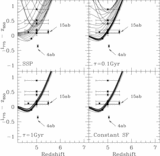Rest-Frame Ultraviolet-to-Optical Properties of Galaxies at z ~ 6 and z ~ 5 in the Hubble Ultra Deep Field: From Hubble to Spitzer
Abstract
We use data from the first epoch of observations with the Infrared Array Camera (IRAC) on the Spitzer Space Telescope for the Great Observatories Origins Deep Survey (GOODS) to detect and study a collection of Lyman break galaxies at z~6-5 in the Hubble Ultra Deep Field (HUDF), six of which have spectroscopic confirmation. At these redshifts, IRAC samples rest-frame optical light in the range 0.5-0.8 μm, where the effects of dust extinction are smaller and the sensitivity to light from evolved stars is greater than at shorter, rest-frame ultraviolet wavelengths observable from the ground or with the Hubble Space Telescope. As such, it provides useful constraints on the ages and masses of these galaxies' stellar populations. We find that the spectral energy distributions for many of these galaxies are best fitted by models of stellar populations with masses of a few times 1010 Msolar and with ages of a few hundred million years, values quite similar to those derived for typical Lyman break galaxies at z~3. When the universe was only 1 Gyr old, some galaxies had already formed a mass of stars approaching that of the present-day Milky Way, and they started forming those stars at z>7 and in some cases much earlier. We find that the lower limits to the space density for galaxies in this mass range are consistent with predictions from recent hydrodynamic simulations of structure formation in a ΛCDM universe. All objects in our samples are consistent with having solar metallicity, suggesting that they might have already been significantly polluted by metals and thus are not comprised of ``first stars.'' The values for dust reddening derived from the model fitting are low or zero, and we find that some of the galaxies have rest-frame UV colors that are even bluer than those predicted by the stellar population models to which we compare them. These colors might be attributed to the presence of very massive stars (>100 Msolar) or weaker intergalactic H I absorption than what is commonly assumed.
- Publication:
-
The Astrophysical Journal
- Pub Date:
- November 2005
- DOI:
- 10.1086/491695
- arXiv:
- arXiv:astro-ph/0507673
- Bibcode:
- 2005ApJ...634..109Y
- Keywords:
-
- Cosmology: Observations;
- Galaxies: Evolution;
- Galaxies: Luminosity Function;
- Mass Function;
- Infrared: Galaxies;
- Astrophysics
- E-Print:
- Accepted for publication in ApJ
